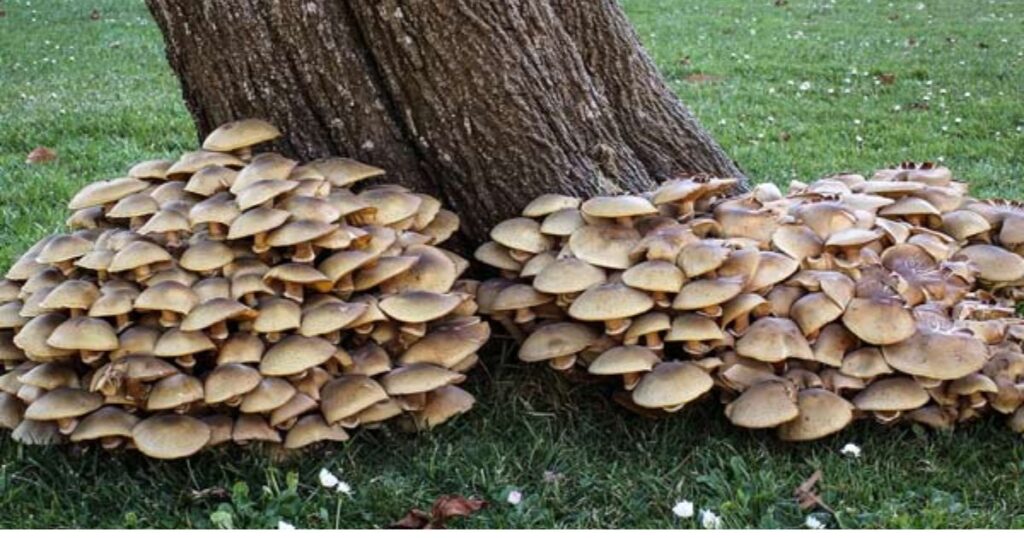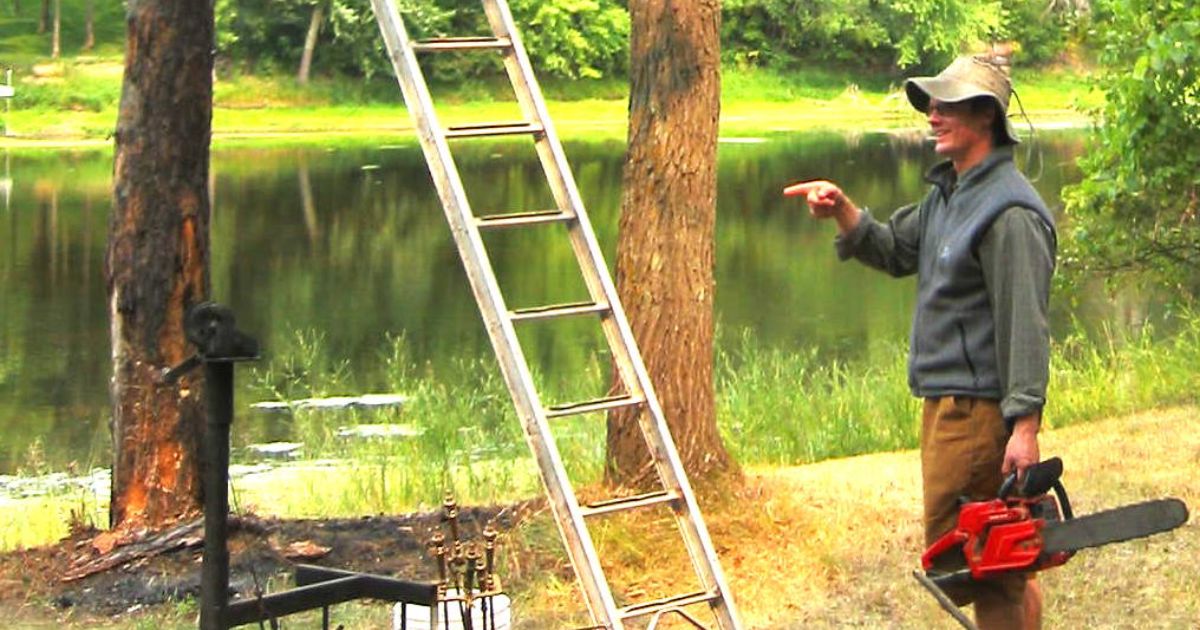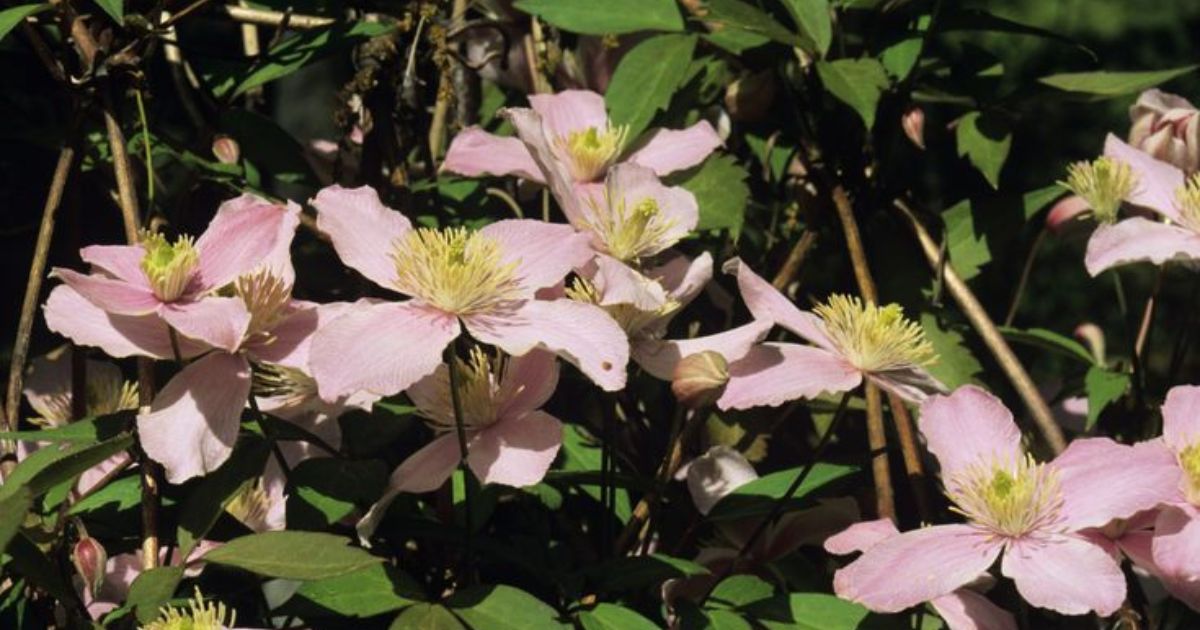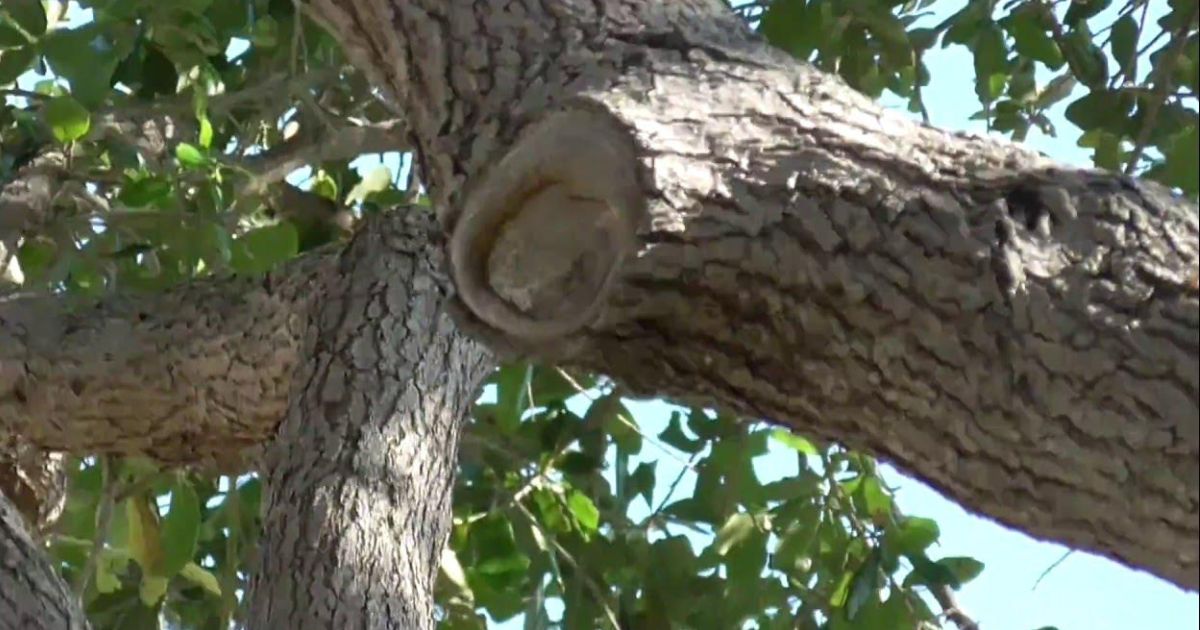Fungi growing on trees can be both fascinating and alarming. While some types of Fungus that grows on trees play a natural role in breaking down dead wood and enriching the soil, others can signal serious problems within a living tree. From colourful shelf-like conks on trunks to clusters of mushrooms at the base, these growths often reveal hidden decay or disease that may threaten the tree’s overall health and stability.
Identifying fungi that grow on trees is crucial for any gardener, arborist, or nature enthusiast seeking to protect and preserve healthy landscapes. Early detection can help prevent further damage, reduce the risk of falling branches, and maintain the beauty and longevity of your trees. In this guide, we’ll explore how to recognise different types of tree Bird’s Nest Fungus, understand their significance, and learn practical steps to manage and prevent fungal growth effectively.
What Causes Fungi to Grow on Trees?
Fungi thrive in environments that provide moisture, organic material, and limited air circulation conditions, often found around trees. When a tree becomes stressed, injured, or weakened, it becomes more vulnerable to fungal invasion. Understanding the leading primary causes of fungal growth can help you prevent serious infections before they occur.
Here are the most common reasons why fungi grow on trees:
Excess Moisture and Poor Drainage
Too much water around the tree’s roots creates the perfect environment for Green Molds pores to thrive. Overwatering, heavy rainfall, or poor soil drainage can lead to root rot, encouraging the growth of mushrooms or bracket fungi at the base of the tree.
Tree Wounds and Physical Damage
Cracks, pruning cuts, storm damage, or animal injuries expose the inner wood of a tree. These open wounds allow fungal spores to enter and establish themselves inside the trunk or branches, How to Prune a Hydrangea in Spring for Healthy Growth leading to internal decay over time.
Deadwood and Decaying Matter
Old or dying branches, stumps, or fallen debris provide food for fungi. Once fungi start feeding on dead tissue, they can spread into nearby living parts of the tree, especially if the tree’s natural defences are weak.
Poor Air Circulation and Dense Shade

Areas with little sunlight and restricted airflow tend to stay damp longer after rain or watering. This prolonged moisture makes the tree’s bark and surrounding soil more susceptible to fungal growth.
Environmental Stress and Weak Immunity
Factors such as drought, nutrient deficiency, pollution, or compacted soil can stress a tree and weaken its immune system. A stressed tree struggles to produce natural defences, making it easier for fungi to invade and grow.
Old Age or Structural Decline
As trees age, their wood naturally becomes softer and more porous. This creates ideal conditions for fungi to colonise, particularly on the trunk and roots where decay has already begun.
By identifying these causes early, you can take proactive steps such as improving soil drainage, pruning properly, and maintaining tree health to reduce fungal problems and extend the life of your trees.
Common Types of Tree Fungi
Tree fungi come in many shapes, sizes, and colours, from delicate powdery coatings on leaves to thick, woody brackets on trunks. While some are harmless decomposers, How to get rid of house plant flies others can slowly destroy a tree’s internal structure. Recognising the most common types of fungi will help you understand what’s growing on your tree and how severe the problem might be.
Below are the most common types of tree fungi and their key characteristics:
Bracket (Shelf) Fungi
Also known as conks, these fungi appear as hard, shelf-like structures that grow horizontally from the trunks or branches of trees. They can range in colour from brown and grey to bright orange.
- Where to Find Them: On trunks, stumps, or large branches.
- Indicates Internal wood decay; the tree may be structurally weak.
- Examples: Artist’s conk (Ganoderma applanatum), Turkey tail (Trametes versicolor).
Mushrooms
Mushrooms are one of the most recognisable types of fungi, often sprouting at the base of trees or along roots. They have a soft, fleshy texture and can appear seasonally, especially after rain.
- Where to Find Them: Around the base or root zone of the tree.
- Indicates: Root rot or decay in underground wood.
- Examples: Honey fungus (Armillaria mellea), Root rot Gilled Mushrooms (Ganoderma species).
Cankers
Cankers are sunken, discoloured, or cracked areas on the tree’s bark, often caused by fungal infection entering through wounds. Over time, they may ooze sap or girdle branches, cutting off nutrient flow.
- Where to Find Them: On bark, branches, or trunks.
- Indicates Infection by wound-invading fungi, with potential for branch dieback.
- Examples: Cytospora canker, Nectria canker.
Powdery Mildew
Powdery mildew appears as a white or grey powdery coating on leaves, stems, or buds. Although not usually fatal, it can weaken the tree, reducing its growth and photosynthesis.
- Where to Find It: On the upper surfaces of leaves and young shoots.
- Indicates: High humidity and poor air circulation.
- Shared Hosts: Maples, oaks, and dogwoods.
Rusts
Rust Lichen produce orange, yellow, or reddish spots on leaves, What Are Basil Black Spots and How Can You Eliminate Them? stems, or fruits. As the disease progresses, the leaves may curl, deform, or drop prematurely.
- Where to Find Them: On leaves and small twigs.
- Indicates: Airborne fungal spores infecting foliage.
- Examples: Cedar-apple rust (Gymnosporangium juniperi-virginianae), Pine needle rust.
Sooty Mould
This black, sooty-looking fungus grows on the surface of leaves and twigs, often feeding on honeydew secreted by sap-sucking insects like aphids.
- Where to Find It: Leaf surfaces and branches.
- Indicates: Insect infestation rather than direct tree infection.
- Effect: Blocks sunlight and interferes with the process of photosynthesis.
Heart Rot
Heart rot is a severe internal decay that affects the heartwood (central core) of the tree. Often invisible until advanced, it causes hollow trunks and structural weakness.
- Where to Find It: Inside trunks and major limbs; sometimes visible through cavities or conks.
- Indicates: Advanced decay and compromised tree stability.
- Examples: Phellinus, Fomes, and Ganoderma species.
Understanding the type of Honey Fungus growing on your tree can provide valuable insights into the tree’s overall health. While some fungi are simply feeding on dead material, others could be silently weakening your tree from the inside out.
Key Signs and Symptoms of Fungal Growth
Detecting fungal growth early can make the difference between saving a tree and losing it entirely. Fungal infections often start subtly, developing on bark, leaves, or roots before showing visible damage. Learning to recognise the key signs and symptoms can help you take timely action and protect your trees from severe decay or disease.
Here are the most common indicators that fungi may be affecting your tree:
Visible Fungal Bodies
One of the most evident signs of fungal activity is the appearance of mushrooms, conks, or shelf-like structures on the trunk, branches, or base of the tree. These fruiting bodies are the reproductive parts of the fungus, indicating that fungal decay is already active within the wood.
Discoloured or Peeling Bark
If you notice areas of bark that are darker, cracked, soft, or peeling away, it could indicate fungal infection beneath the surface. Some fungi break down bark tissues, making them easy to lift or flake off.
Oozing Sap or Sticky Secretions
Fungal infections can cause trees to exude sap or sticky fluid, sometimes accompanied by an unpleasant odour. These wet spots or patches may appear on the trunk or lower branches, signalling decay inside.
Soft or Spongy Wood
When wood becomes soft, crumbly, or spongy to the touch, it typically indicates that internal rot has begun. This is common in trees infected with heart rot or root decay fungi, which slowly eat away the structural core.
Wilting or Discoloured Leaves
If your tree’s leaves start to yellow, brown, curl, or fall prematurely, it may be suffering from a root or vascular fungal disease. This occurs when the fungus interferes with the tree’s ability to transport water and nutrients.
Hollow Trunks or Cavities
As Brittle Cinder Fungus consume the inner wood, they can create hollow sections inside the trunk or large limbs. Although the tree may still appear healthy externally, it can be structurally weak and prone to falling during storms.
Unpleasant or Musty Odour
A sour, mouldy, or musty smell near the base of a tree is another telltale sign of fungal decay. This odour often accompanies root or heart rot infections that are hidden below the soil line.
Growth of Lichens or Moss (Often Misidentified as Fungi)
While not technically fungi, lichens and mosses growing on bark are sometimes mistaken for fungal infections. They don’t harm the tree but may indicate damp, shaded conditions that also favour fungal growth.
By paying attention to these warning signs, you can identify fungal problems early and take corrective measures such as pruning infected areas, improving Drainage, or consulting a professional arborist to restore your tree’s health before the infection spreads.
Step-by-Step Guide to Identifying Tree Fungi
Identifying Coral Spot Fungus that grow on trees may seem challenging at first, but with a careful approach, you can learn to recognise key features that reveal both the type of fungus and the possible condition of your tree. The following step-by-step guide will help you systematically observe, document, and understand the fungal growth before deciding on treatment or removal.
Observe the Location of the Fungal Growth
Begin by identifying the location where the fungus is growing on the tree.
- On the trunk or branches, this often indicates heart rot or canker diseases.
- At the base or roots: Suggests root rot or internal decay.
- On leaves or twigs: Typically a foliar fungus, such as rust or powdery mildew.
- The location can tell you whether the fungus is feeding on living tissue or decaying wood.
Examine the Shape and Structure
Fungi come in many shapes: shelf-like, round, flat, or mushroom-shaped.
- Bracket (conk) fungi: Hard, woody structures projecting from the bark.
- Mushrooms: Soft, umbrella-like caps often appear after rainfall.
- Crusty or powdery textures: Common with leaf and bark infections.
- Careful observation of form helps narrow down the type of fungus involved.
Note the Color and Texture
Take note of the Oyster Mushrooms colour, texture, and consistency.
- White, cream, or brown: Common colours for wood-decaying fungi.
- Bright orange, yellow, or red: This may indicate the presence of rusts or slime moulds.
- Powdery or velvety coatings often indicate surface-level leaf infections.
- Touching should be done cautiously, preferably with gloves, to prevent the spread of spores.
Check the Season and Weather Conditions
ManyChicken of the Woods appear seasonally, thriving in humid, wet conditions or following rainfall.
- Summer and fall: Common times for mushroom and bracket fungi to emerge.
- Spring: Leaf-based fungi, such as rusts and powdery mildew, are most active.
- Documenting the timing helps you identify seasonal fungi that match your local climate.
Inspect for Tree Health Symptoms
Look for signs that the tree is stressed or infected, such as:
- Wilting or yellowing leaves
- Cracked bark or oozing sap
- Soft or hollow wood
- Reduced growth or canopy thinning
- These symptoms indicate whether the fungus is merely present or actively harming the tree.
Compare with Reference Images or Field Guides
Use reliable tree fungus identification guides or online resources with clear photographs. Compare the fungus’s size, colour, and texture with known species. You can also use mobile apps or local forestry websites for visual identification.
Consult an Arborist or Mycologist for Confirmation
If you’re unsure or suspect a severe infection, consult a certified arborist or plant pathologist. They can analyse tissue samples or use lab tests to determine the exact fungus type and suggest the best treatment plan.
Document Your Findings
Take photos, notes, and dates of your observations. This record helps track fungal growth over time and provides valuable information if you later seek expert advice.
By following these steps, you’ll gain a clearer understanding of the fungus affecting your tree, whether it’s harmless decay or a severe disease requiring immediate action. Accurate identification is the first step toward effective management and long-term tree health.
How Fungi Affect Tree Health
Fungi play a complex role in the ecosystem. Some species help trees absorb nutrients, while others cause serious diseases that weaken or kill them over time. When harmful fungi infect a tree, they disrupt the tree’s internal systems, decompose vital tissues, and compromise its overall stability. Understanding howJack-o’lantern Mushrooms affect tree health is crucial for managing infections before they become irreversible and irreparable.
Below are the main ways fungi impact the health and structure of trees:
Internal Wood Decay
Many fungi attack the heartwood, the strong, central part of the tree, causing it to rot from the inside. This decay often goes unnoticed until fruiting bodies (like mushrooms or conks) appear on the trunk. As the inner wood breaks down, the tree becomes structurally weak and more likely to fall during strong winds or storms.
- Example: Heart rot fungi such as Ganoderma and Phellinus species.
Root Rot and Nutrient Disruption
Fungi like Armillaria (honey fungus) and Phytophthora target the root system, causing root rot. When roots decay, the tree can no longer absorb sufficient water and nutrients, resulting in yellowing leaves, wilting, or slow growth. Severe root rot can cause the tree to die suddenly, even if the canopy appears healthy for a while.
Bark and Cambium Damage
Some fungi infect the bark and cambium layer, the living tissue that transports nutrients and water between roots and leaves. These infections can cause cankers or sunken patches on the bark, which eventually cut off the nutrient flow, leading to branch dieback or death of the entire section of the tree.
- Example: Cytospora and Nectria cankers.
Leaf Infections and Reduced Photosynthesis
Fungal diseases, such as powdery mildew and rust, attack the leaves, coating them with powdery spores or creating discoloured spots. This reduces the tree’s ability to photosynthesise, weakening it over time. In severe cases, repeated infections can cause premature leaf drop, stunted growth, and reduced fruit or flower production.
Structural Weakness and Safety Risks
When fungi weaken the internal wood or root systems of a tree, it becomes unstable. Even if it appears healthy on the outside, a fungus-infected tree may have hollow or brittle sections that can break easily. This poses a serious safety hazard, especially in residential or public spaces where falling branches could cause injury or property damage.
Secondary Pests and Infections
Fungal infections often attract insects and other pathogens, which further accelerate the decay process. Beetles, termites, and borers are commonly attracted to rotting wood, which exacerbates the damage and accelerates the decline of the tree.
Death of the Tree
If left untreated, severe fungal infections can result in the complete death of the tree. Once the fungus has spread through the vascular system or destroyed the root network, recovery becomes nearly impossible. Removing the infected tree is often the only safe option to prevent the spread of spores to nearby plants.
Ecological Impact
While harmful to individual trees, decaying fungi play a natural role in recycling nutrients back into the soil. They help decompose dead wood, returning carbon and minerals that support the growth of new plants. However, in managed gardens or landscapes, controlling pathogenic fungi is essential to maintain healthy, living trees.
Fungal infections may start small, but their long-term effects can be devastating. Regular inspections, prompt pruning of infected branches, and maintaining proper soil and moisture balance are the best defences against these silent tree killers.
Prevention and Control Tips
Preventing fungal growth on trees is far easier and more effective than trying to treat an advanced infection. Since fungi thrive in damp, poorly ventilated, or damaged environments, the key is to maintain strong, healthy trees and reduce the conditions that favour fungal activity. Below are some practical prevention and control tips to keep your trees fungus-free and thriving throughout the year.
Prune Properly and Regularly
Pruning helps improve air circulation and sunlight penetration through the canopy, thereby reducing moisture buildup, a common trigger for fungal growth.
- Always use clean, sterilised tools to avoid spreading spores.
- Prune during dry weather to allow wounds to heal faster.
- Remove dead, diseased, or crossing branches promptly.
Avoid Overwatering and Improve Drainage
Excess water around roots creates the perfect environment for fungi.
- Water deeply but infrequently, allowing soil to dry slightly between sessions.
- Ensure proper Drainage around the base by avoiding compacted or waterlogged soil.
- Use mulch carefully, keeping it a few inches away from the trunk to prevent rot from occurring.
Remove Decaying Wood and Organic Debris

Fungi often start on deadwood, fallen branches, or old stumps, then spread to nearby trees.
- Regularly clear away decaying plant matter from your garden.
- If a tree is heavily infected, consider obliterating it to protect others.
Boost Tree Health with Proper Nutrition
Healthy trees can resist fungal infections better than weak ones.
- Apply balanced fertilisers suited to your tree species and soil type.
- Test your soil regularly to maintain the proper pH and nutrient balance.
- Ensure trees are not planted too closely together, as this can trap moisture and limit airflow.
Use Fungicides When Necessary
For mild fungal infections, fungicidal sprays or treatments can be effective, but they should always be used correctly and in accordance with the manufacturer’s instructions.
- Select a product labelled for use on trees and follow the directions carefully.
- Apply preventatively in humid seasons when fungal spores are most active.
- For severe cases, seek professional arborist advice before application.
Avoid Tree Injuries
Tree wounds from lawnmowers, pruning, Why Fall is the Best Time to Plant Trees or storms can become entry points for fungi.
- Use protective guards around trunks when mowing or trimming to prevent damage to the trunks.
- Seal significant pruning cuts with an approved tree wound dressing to discourage fungal spores.
Maintain Proper Air Circulation
Dense planting or overgrown branches trap humidity, promoting fungal development.
- Space trees and shrubs adequately during planting.
- Periodically thin out the canopy to allow better airflow and sunlight penetration.
Monitor and Inspect Trees Regularly
Routine inspections can help you identify early signs of fungal growth before it spreads.
- Check for mushrooms, discoloured bark, or oozing sap.
- Look for leaf spots or premature defoliation.
- Early detection enables quicker and less invasive treatment.
Seek Professional Help for Severe Infections
If the fungus appears deep within the trunk or the tree shows signs of structural weakness, it’s best to call a certified arborist or tree specialist. They can accurately identify the fungus and recommend treatments such as root aeration, injections, or safe removal if necessary.
By following these prevention and control practices, you can create an environment that discourages fungal growth and supports long-term tree health. Healthy, well-maintained trees are naturally more resistant to disease, making prevention the most potent tool against fungi.
When to Seek Professional Help
While some minor fungal growths can be managed through pruning and basic care, others indicate more severe, potentially dangerous problems that require expert attention. Knowing when to seek professional help can save not only your tree but also your property and safety. Arborists and tree care specialists are trained to diagnose complex fungal issues, identify hidden decay, and recommend appropriate treatments.
Here are the key situations when calling a professional is essential:
Rapid or Widespread Fungal Growth
If you notice fungi spreading quickly over the bark, roots, or branches, it’s a sign of an aggressive infection. Fast-growing fungi can consume living tissues and weaken the tree from the inside out, making quick professional intervention critical.
Large Mushrooms or Conks on the Trunk or Base
The presence of large bracket fungi, also known as conks, on the trunk or near the base often indicates internal decay or root rot. These are not surface problems; they suggest that the fungus has likely invaded the tree’s core, How to Make a Christmas Tree Last Longer compromising its structural integrity. An arborist can assess whether the tree is still stable or needs removal.
Signs of Structural Weakness
If your tree exhibits cracks, hollow areas, leans, or has dead limbs, it may collapse without warning. Fungal decay can hollow out the trunk, leaving it looking healthy externally but dangerously weak internally. Professionals use resistograph or sonic tomography tests to check internal strength and stability.
Repeated or Persistent Infections
When the same fungal issue returns every year, even after treatment, it means the fungus has become systemic or the underlying cause (like poor Drainage or root damage) hasn’t been resolved. Arborists can identify and address the root cause to prevent future infections.
Leaf and Branch Dieback
If leaves are wilting, yellowing, or dying from the top down, and pruning doesn’t help, the infection may have reached the vascular system. Diseases such as Verticillium wilt or Armillaria root rot require laboratory testing and targeted management, which can only be provided by a professional.
Nearby Trees Are Getting Infected
Fungal spores can travel through the air, soil, or through contact with roots. If multiple trees in the same area begin showing similar symptoms, it’s crucial to consult an arborist immediately to prevent a broader outbreak.
Unidentified or Unusual Fungal Growth
Some fungi closely resemble harmless species but are actually highly destructive. If you encounter a strange-looking fungus and can’t identify it confidently, a professional mycologist or tree pathologist can perform lab analysis to confirm its type and risk level.
Safety Concerns

If a fungus-infected tree is located near your home, walkway, or power lines, it poses a significant safety hazard. Professionals can assess the danger, perform controlled pruning or removal, and ensure the area remains safe and secure.
Seeking expert help isn’t just about saving a single tree; it’s about maintaining the overall health of your landscape and preventing further damage. Certified arborists possess the necessary tools, experience, and scientific knowledge to accurately diagnose fungal problems and recommend the safest and most effective solutions.
Conclusion
Fungi growing on trees can reveal a great deal about the health of your landscape. Sometimes, they are a natural part of decomposition, but often, they signal deeper problems, such as decay, root rot, or internal weakness. By learning to identify different types of fungi and understanding their causes, you can take early, effective action to protect your trees before the damage becomes irreversible.Healthy trees are naturally resistant to fungal infections, so proper care is your best defence. Regular pruning, balanced watering, good air circulation, and routine inspections help prevent the conditions that fungi love. And when signs of severe infection appear, such as large conks, rapid decay, or structural instability, don’t hesitate to call a certified arborist for expert evaluation.
In short, identifying and managing tree fungi isn’t just about aesthetics; it’s about preserving the strength, safety, and longevity of your trees. With awareness and proactive care, you can keep your garden thriving and your trees standing tall for years to come.
FAQ
What are the most common fungi that grow on trees?
The most common fungi include bracket fungi (conks), mushrooms, rusts, powdery mildew, cankers, and root rot fungi. Each has distinct signs and affects trees differently, ranging from harmless decomposers to dangerous pathogens.
Are all fungi harmful to trees?
No. Some fungi play a beneficial role by breaking down deadwood and recycling nutrients into the soil. However, pathogenic fungi can infect living trees, causing decay, structural weakness, and even death.
How can I tell if the fungus on my tree is dangerous?
Dangerous fungi often produce large fruiting bodies on trunks or roots, causing cankers that soften the wood or lead to premature leaf drop. Rapid spread, foul odours, or structural changes in the tree are strong warning signs. Professional assessment is recommended for certainty.
Can I remove tree fungi myself?
Small surface fungi on leaves or minor mushrooms can be removed manually. However, most serious fungal infections involve internal decay, requiring specialised knowledge and tools. For significant or recurring fungi, professional help is best to prevent further damage.
How can I prevent fungal growth on my trees?
You can prevent fungal growth on trees by pruning regularly, ensuring proper Drainage, avoiding overwatering, removing deadwood, maintaining good air circulation, applying fungicides when needed, and keeping tree bases clean.





